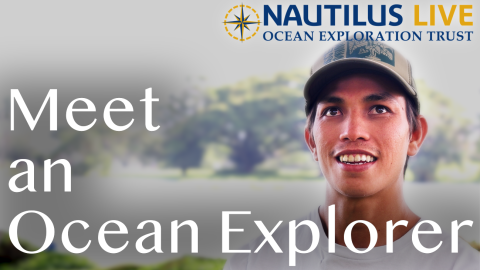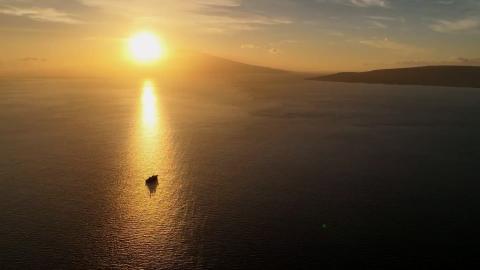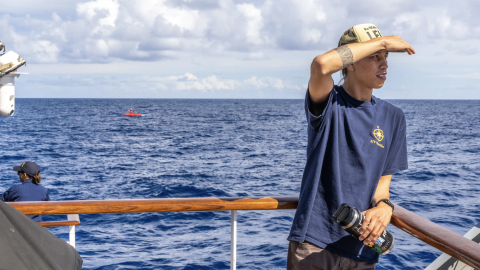
Kainalu Steward
Tell us about your work/research. What kinds of things do you do?
Currently, my graduate research revolves around understanding the impacts of sea-level rise and hurricanes to atoll island systems, specifically the atoll known as Lalo (French Frigate Shoals) located within the Papahānaumokuākea Marine National Monument. Recently in October of 2018, a category 3 hurricane named Walaka came through and devastated the islets of Lalo. A huge component of my research is monitoring the recovery of these atoll islets to hopefully inform future management practices and decisions. Most of my work consists of using satellite imagery and ArcGIS software to monitor shoreline change and the movement of these resilient islets. Another part of my research includes collecting GPS points around the islets to get a better understanding of their location. One fact and an important reason why Lalo is significant is that 90% of the total Hawaiian sea turtle population relies on and migrates to Lalo for nesting each year.
What sparked your initial interest in your career?
My passion and curiosity for the ocean started at a young age. I was fortunate to grow up on an island close to the coast, so a lot of my time was spent near and in the ocean. Most of my free time was usually spent surfing or simply going to the beach with family and friends. Having this relationship with these spaces always made me curious to understand my home better. These experiences have definitely sparked my interest in understanding these systems that I've grown up to love and have a deep respect for.
Who influenced or encouraged you the most?
My ʻohana or family have always been a huge influence and encouragement throughout my life. When I think of who has influenced me the most in terms of science and academia, it would definitely have to be my mentors and various teachers that guided me during my undergraduate time. These were people that I could see myself in and always made me feel like I belong in this field. I would like to add that nearly all my mentors have been indigenous women in STEM, and they continue to pave the way. I am very grateful to have these relationships and mentorships in my life.
What element of your work/study do you think is the most fascinating?
I think the most fascinating thing about my work is being able to make connections between the scientific processes and the home that I've grown up around. Growing up, I would always hear about the sea-level rise or notice seawall structures being built but I never understood why or what that really meant. I think also being able to gain hands-on experience in this field, such as using high-grade GPS devices and applying mapping skills in ArcGIS software has been very rewarding.
What other jobs led you to your current career?
A lot of various internships that I've participated in during my undergraduate have led me to this path of science and what I do now. My projects have ranged from doing water quality sampling and analysis along the coastline in Hilo to researching freshwater water crabs in southern Costa Rica, as well as studying primary production within loko iʻa or traditional Hawaiian aquaculture systems along the Hilo coastline. I also have experience with science education through volunteering at local charter schools and assisting them with their science projects. I'm always stoked when I can get our youth excited about learning more about their homes and places they've grown up through participating in observation and scientific research.
What are your degrees and certifications?
Bachelor of Arts in Hawaiian Studies with a Marine Option Program (MOP) certificate -- the University of Hawaii at Hilo 2020; I am currently a graduate student in the Tropical Conservation Biology & Environmental Science program also at the University of Hawaii at Hilo and expected to graduate in the Spring of 2022.
What are your hobbies?
I usually love to surf or be near the ocean in my free time with friends and family. I also love to try out new cooking recipes once in a while.
How did you get involved with the Ocean Exploration Trust?
I first heard about the Ocean Exploration Trust through the lab that I currently am a part of called the Multi-Scale Environmental Graphical Analysis (MEGA) lab at the University of Hawai'i at Hilo. Huge shoutout to Dr. John Burns who is the head of the lab and Dr. Haunani Kane who I currently work under. They definitely pushed me to apply as a data logger intern with hopes to gain new and valuable skills.
What advice would you give someone who wants to have a career like yours?
I would say don't be afraid to jump into the work, even if you have no experience but show interest and determination to get the job done. Internships during the school year or even during the summer are a great way to build new skills in the field by gaining hands-on experience. Youʻll never know where that experience might take you to, so always be open to learning and growing! Find your support system whether that might be your classmates, a club, or even your teachers, and surround yourself with people who support your goals. Mentorship was also huge throughout my journey, and I am grateful to have had solid mentors that I truly look up to and could see myself in. Definitely don't be afraid to ask for help or advice from others and take advantage of the different resources that you might have access to. Finally, I would say get involved with your community or the community that you currently are a part of and make it an effort to build relationships with those people and places.
Expeditions
Kainalu participated in the following Ocean Exploration Trust expeditions:



